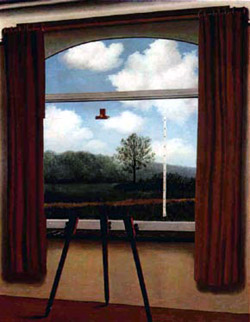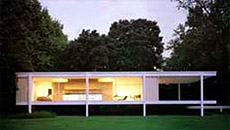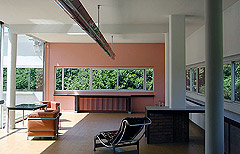window
The ordinary windows in our houses demarcate a pervious boundary between inside and outside, between private and public - this boundary can be crossed by looking through the window from either side. The transparent glass panes of the windows are vulnerable to both physical attacks and to the curious gaze of the passer-by or the person living across the street, and we try to prevent the look inside by putting up curtains. At the same time, we appreciate the sunlight falling through the windows, are ready to pay a higher price for a home with a nice view, and decorate our windows, thereby exemplifying the window above all as a place of the visual, and as a place of visual display (most obviously in the shop-window). This intimate relation between the window, seeing, and perception (cf. eye/gaze) has become part of everyday language: the eyes as windows to the soul (or heart, or mind) [1] point out the possibility of looking inside a person through the opening of his eyes, where an inner state is reflected; a window is called 'blind', when we cannot look through it; accordingly 'window-blinds' are used to cover the transparent window. While the actual window can be understood as mediating between spaces, and thus as a site of communication, it is mainly its metaphorical use for other (visual) media like painting, television, or computer interfaces that link it to media theories. Looking closer at these metaphors reveals that the seemingly familiar window might actually not be transparent, but rather concealing what is on its other side.
The notion of seeing is already implied in the term window itself , which derives from the Middle English vindauga, eye of the wind (vindr = wind + auga = eye) replacing the Old English eyethurl. In the Latin term fenestra (from which French, Italian, German and others derive their terms for window) notions of opening, showing, and light are implied. [2] In its most general definition a window is an "opening in a wall or a side of a building, ship or carriage, to admit light and air, or both, and to afford a view of what is outside or inside." [3] The window as an opening in a wall refers to an absence which can be filled - by a material (glass, wood, paper, stone), by that which is seen through it, or by something rather immaterial like light or air. If defined as an absence, the window becomes a frame for its variable content, a marker of difference between what is inside and outside.
As the window has been closely related to the visual, it was taken up as a metaphor in the realm of visual media, such as painting. In his treatise on painting, the 15th century architect, sculptor, painter, and theorist Leon Battista Alberti described painting as the construction of an image that resembles a window: "First of all, on the surface on which I am going to paint, I draw a rectangle of whatever size I want, which I regard as an open window through which the subject to be painted is seen;..." [4]. On this basis, Alberti formulated the method of one-point linear perspective, which marks a turning point in the development of naturalistic representation. The window could serve as such a convincing simile for painting, because of its formal resemblance, and, more importantly, because it enabled illusionist representation of three-dimensional objects on a two-dimensional surface by value of its transparency, thus denying the material surface of the canvas. Painting as a view through the window became an extension of the natural world, where the beholder's space and the picture space are meant to form a continuum, connected by the gaze of the beholder penetrating the 'transparent' canvas - an illusion depending on the construction of (and looking at) the painting from a single, stable point of view.
 This method was illustrated by Albrecht Dürer in his Instruction on Measurement (fig.1), where the draftsman is shown looking through a transparent screen with a grid on his model, while stabilizing his eye with the help of a stick - this illustration also reveals the artificiality of linear perspective. [5] Beside the transparent screen are two more windows shown in Dürer's woodcut opening onto a landscape outside the draftsman's room - they might be understood as another hint to the painting-as-window equation. Since the Renaissance, windows were frequently depicted and can often be understood as a painting-within-a-painting (or a window-within-a-window), reflecting on the nature of painting as a window, therefore functioning as a 'meta-picture.' This is still the case in the OEuvre of René Magritte, who employed the confrontation of a painted canvas with a (painted) view out of a window, such as in La Condition Humaine I (fig. 2), playing out the ambiguity of a painting within a painting and the painting-as-window, of inside and outside, and of perception itself: "The problem of the window led to The Human Condition . (...) Thus the tree depicted in the painting hid from view the tree situated behind it, outside the room. The tree existed for the spectator inside the room in the painting, and, simultaneously in his mind, outside, in the real landscape. That is how we see the world: we see it existing outside ourselves, and yet we have only a mental representation of it inside ourselves." [6] [see screen, (2)]
This method was illustrated by Albrecht Dürer in his Instruction on Measurement (fig.1), where the draftsman is shown looking through a transparent screen with a grid on his model, while stabilizing his eye with the help of a stick - this illustration also reveals the artificiality of linear perspective. [5] Beside the transparent screen are two more windows shown in Dürer's woodcut opening onto a landscape outside the draftsman's room - they might be understood as another hint to the painting-as-window equation. Since the Renaissance, windows were frequently depicted and can often be understood as a painting-within-a-painting (or a window-within-a-window), reflecting on the nature of painting as a window, therefore functioning as a 'meta-picture.' This is still the case in the OEuvre of René Magritte, who employed the confrontation of a painted canvas with a (painted) view out of a window, such as in La Condition Humaine I (fig. 2), playing out the ambiguity of a painting within a painting and the painting-as-window, of inside and outside, and of perception itself: "The problem of the window led to The Human Condition . (...) Thus the tree depicted in the painting hid from view the tree situated behind it, outside the room. The tree existed for the spectator inside the room in the painting, and, simultaneously in his mind, outside, in the real landscape. That is how we see the world: we see it existing outside ourselves, and yet we have only a mental representation of it inside ourselves." [6] [see screen, (2)] 
In architecture, windows have taken on all kinds of forms (rectangular, square, curved, pointed) and come with all sorts of decoration or framing (pillars, pilasters, pediments, sills). Besides their functional aspect of allowing light and air into the building, windows and their frames have been the most important structuring element of the facade, pointing out the inner structure of the building on its outside. But also the view to the outside has been carefully considered, for example when gardens and parks were designed at least partly to correspond with what could be seen of them from inside the house. Glass windows have only been widely used since the 15th century; before, they were seldom used in secular architecture but employed in Gothic churches, where the stained glass windows could penetrate the wall to such an extent that only a skeletal stone framework would be left to support them. The stained glass windows played a two-fold role: "The visible reality of a gothic church window can be defined as the specific treatment of an iconographic theme and as details of its 'style'; (...), but the visual reality of the same church window is first of all the mode of conceptualizing picture matter in the Middle Ages, so that the persons entering a cathedral perceived themselves as walking through light and colour: a mysterious colour, let in high above through the windows within a disparate network of hardly identifiable zones, which were conceived as holy... " [7] (cf. Show & Tell on Stained Glass). Besides colour, transparency and reflection were the properties of glass most valued in architecture.
 Since the early twentieth century, windows have become larger in size - a development that culminated in houses such as Ludwig Mies van der Rohe's Farnsworth House (fig.3). In this case, wall and window collapse into each other, the window is no longer a hole in the wall but the wall itself, thus merging interior and exterior. At the same time, the effect is that the interior of the house becomes a framed image when viewed from the outside, while the surrounding becomes a framed image when viewed from the inside. According to Beatriz Colomina, Le Corbusier was mainly interested in framing views with his horizontal windows (fig.4), which he understood "first of all (as) communication" [8]: "The house is a system for taking pictures. What determines the nature of the picture is the window." [9]. Colomina further relates this interest of Le Corbusier to his engagement with the reality of mass media, where "the window in the age of mass communication provides us with one more flat image. The window is a screen." [10]
Since the early twentieth century, windows have become larger in size - a development that culminated in houses such as Ludwig Mies van der Rohe's Farnsworth House (fig.3). In this case, wall and window collapse into each other, the window is no longer a hole in the wall but the wall itself, thus merging interior and exterior. At the same time, the effect is that the interior of the house becomes a framed image when viewed from the outside, while the surrounding becomes a framed image when viewed from the inside. According to Beatriz Colomina, Le Corbusier was mainly interested in framing views with his horizontal windows (fig.4), which he understood "first of all (as) communication" [8]: "The house is a system for taking pictures. What determines the nature of the picture is the window." [9]. Colomina further relates this interest of Le Corbusier to his engagement with the reality of mass media, where "the window in the age of mass communication provides us with one more flat image. The window is a screen." [10] 
This relationship is also discussed by Lynn Spigel, who describes the coincidence of the big glass window (called 'picture window') in postwar American architecture with the moving in of the television into domestic space. [11] Television has been called a 'window on the world,' [12] thus, similar to painting-as-window, the materiality of the TV screen and the technology producing a picture on it are denied, stressing the view on far away places within the living room. Both the big 'picture window' and the television screen, can be understood as creating a "spatial ambiguity between public and private space"; at the same time both were perceived as dangerous, because they could allow the view into the private. Though TV could not look back, this exact anxiety was a repeated issue in TV shows, magazines, and literature, such as in George Orwell's 1984. [13] The controlling gaze in relation to the glass window is also mentioned by Marshall McLuhan, who treats the whole house as a medium because it is one of the many 'extensions of man': "Not many ages ago, glass windows were unknown luxuries. With light control by glass came also a means of controlling the regularity of domestic routine, and steady application to crafts and trade without regard to cold or rain. The world was put in a frame." [14] But the transparency of glass could also take on a positive political connotation, such as in German post-war-architecture, where the transparency of glass stands for the transparency of the democratic government, which is still the case for the glass reconstruction of the dome of the former Reichstag in Berlin by Norman Foster (fig.5).

Recently, even more windows have appeared in our environment: on the computer screen we can open yet another 'window', looking 'through' the computer screen on several, sometimes overlapping windows, each presenting another document (a text, images, music files, websites etc.). The use of the term 'window' for a part of the computer screen is related to the development of the Graphical User Interface (GUI) [see graphic], which replaced the typing of keyboard commands with the mouse's pointing at icons, thus transforming our interaction with the computer from a text-based to an image-based 'language,' which is conceived to be more intuitive. The first attempts for the development of a GUI were made in the mid-1970s by Xerox, but the first commercial system which became popular was the Apple Macintosh in 1984. One year later, Microsoft followed with the release of Windows 1.0 as an extension of its former DOS operating system. [15] Different from painting or television, the window on the computer screen is less an illusion of looking through the screen onto the 'real world' but serves to hide the actual operations of a binary system; instead it contains the familiar old media of text and images. The form of screens has, in the last few years, approximated the form of older media, such as painting or the actual window. Television and computer screens have become increasingly flat, and can be hung on the wall. At the same time, attempts are being made to move away from graphic interfaces through introducing speech recognition and other forms of interaction.
The window as a concept has been, throughout the ages, related to the senses, especially to seeing and visual perception - apparently easy was its transfer from the 'old' medium of painting to the newer ones of television and the computer - but maybe the window, understood as a condition, or a model, for seeing and interacting with the world has also influenced how we give shape to these media.
Julia Orell
Department of Art History
Winter 2003